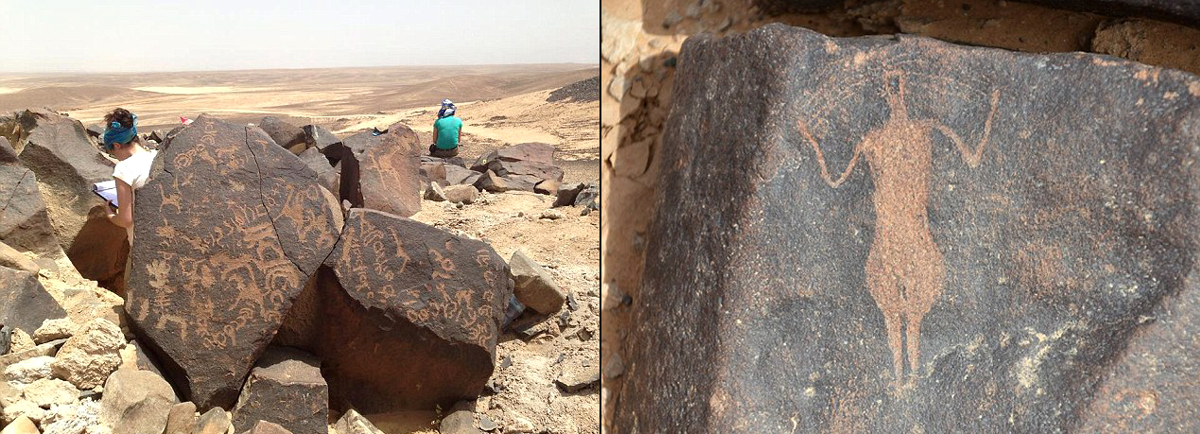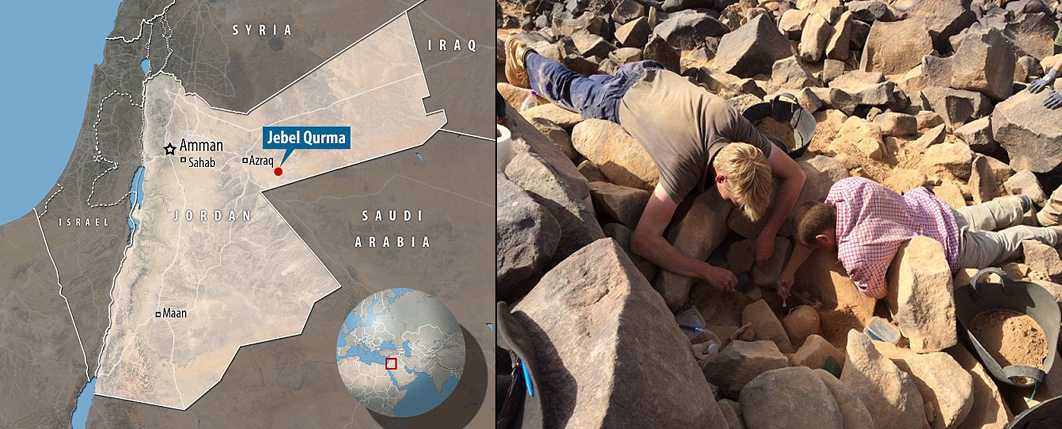


An article by Libby Plummer for MAILONLINE - Revealed: 2,000-year-old rock art in Jordan's Black Desert suggests the barren area was once full of trees, wildlife and nomads - reports on the petroglyphs discovered in the Jebel Qurma region of Jordan.

Researchers analysing rock art in Jordan's Black Desert. Images: Peter Akkermans & the Jebel Qurma Project.
The find was made in the Jebel Qurma region of Jordan's Black Desert by researchers on the Jebel Qurma Archaeological Landscape Project, which seeks to study Jordan's extensive basalt-strewn northeastern desert Jebel Qurma Project. In research carried out between 2012 and 2016, more than 5,000 pieces of ancient rock art have been discovered in Jordan's Black Desert.
Discovery of rock art in the Black Desert of Jordan #petroglyphs https://t.co/uEZT5tuREm #Safaitic #archaeology pic.twitter.com/SA59XBJC1V
— Bradshaw Foundation (@BradshawFND) November 28, 2016
The Jebel Qurma region of Jordan's Black Desert. Image: the Jebel Qurma Project
The petroglyphs were made in Safaitic, a script used by ancient nomads of this region (now Syria, Jordan and Arabia). There are also depictions of various animals including lions, gazelles, ostriches and horses. The rock art clearly suggests that the now desert landscape was once much greener, supporting wildlife and a human population.

The Jebel Qurma region of Jordan's Black Desert. Image: Mailonline. Researchers on the Jebel Qurma Archaeological Landscape Project sifting through Jordan's extensive basalt-strewn northeastern desert. Image: the Jebel Qurma Project.
The research is being carried out by the Jebel Qurma Archaeological Landscape Project. The area is one of the least explored in the region, partly due to the inhospitable environment. The project includes an international team of researchers, led by Professor Peter Akkermans of Leiden University in the Netherlands.
Professor Akkermans states that there are literally many thousands of Safaitic inscriptions and petroglyphs in the Jebel Qurma region, which suggests that people intensively used the area. Much of the text represents names of people, while some gives more detailed hints of how the ancient population spent their time. His team has systematically documented more than 5,000 petroglyphs and inscriptions in the Jebel Qurma region, something which has never been done before in this way.

The ancient script as well as petroglyphs being recorded. Image: the Jebel Qurma Project.
As well as the rock art, the archaeologists also found evidence of camps, shelter and tombs. A study detailing the find is published in the American Journal of Archaeology.
Explore the Rock Art Archive of the Middle East:
http://www.bradshawfoundation.com/middle_east/index.php
by Bradshaw Foundation
Monday 03 February 2025
by Bradshaw Foundation
Friday 09 August 2024
by Bradshaw Foundation
Wednesday 24 July 2024
by Bradshaw Foundation
Thursday 04 July 2024
by Bradshaw Foundation
Monday 01 July 2024
by Bradshaw Foundation
Wednesday 20 March 2024
by Bradshaw Foundation
Tuesday 13 February 2024
by Bradshaw Foundation
Tuesday 13 February 2024
by Bradshaw Foundation
Thursday 01 February 2024
by Bradshaw Foundation
Tuesday 28 November 2023
by Bradshaw Foundation
Thursday 23 November 2023
by Bradshaw Foundation
Monday 20 November 2023
by Bradshaw Foundation
Tuesday 31 October 2023
by Bradshaw Foundation
Thursday 26 October 2023
by Bradshaw Foundation
Wednesday 20 September 2023
by Bradshaw Foundation
Monday 17 July 2023
by Bradshaw Foundation
Monday 03 February 2025
by Bradshaw Foundation
Friday 09 August 2024
by Bradshaw Foundation
Wednesday 24 July 2024
by Bradshaw Foundation
Thursday 04 July 2024
by Bradshaw Foundation
Monday 01 July 2024
by Bradshaw Foundation
Wednesday 20 March 2024
by Bradshaw Foundation
Tuesday 13 February 2024
by Bradshaw Foundation
Tuesday 13 February 2024
by Bradshaw Foundation
Thursday 01 February 2024
by Bradshaw Foundation
Tuesday 28 November 2023
by Bradshaw Foundation
Thursday 23 November 2023
by Bradshaw Foundation
Monday 20 November 2023
by Bradshaw Foundation
Tuesday 31 October 2023
by Bradshaw Foundation
Thursday 26 October 2023
by Bradshaw Foundation
Wednesday 20 September 2023
by Bradshaw Foundation
Monday 17 July 2023
Friend of the Foundation











